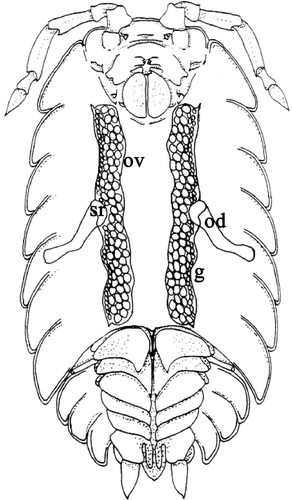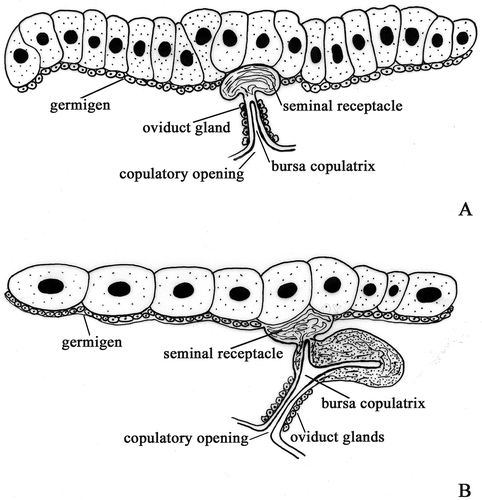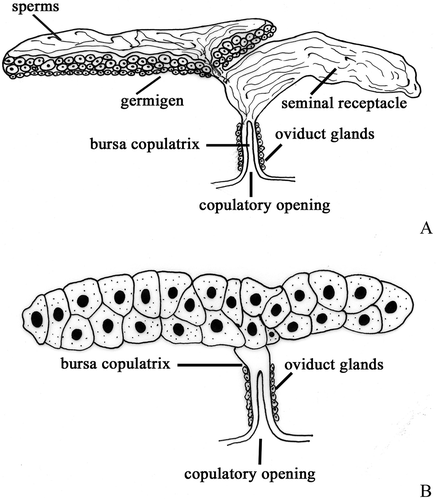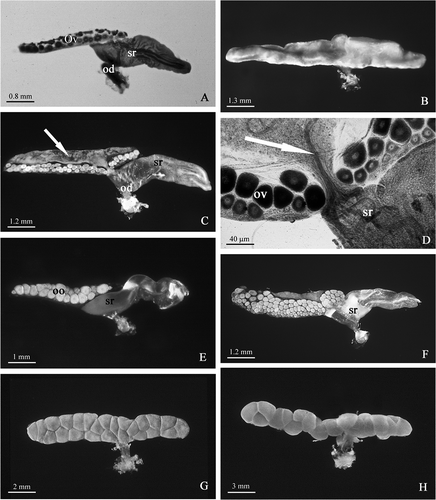Figures & data
Figure 1. Schematic drawing of the female genital system of an oniscidean isopod (ventral vision). Ov, ovaries; od oviduct; sr, seminal receptacle; g, germigen.

Figure 2. Schematic drawing of female genital system. A, ‘Common’ pattern. B, ‘Trichoniscus’ pattern.

Figure 3. A, Armadillidium granulatum. Female at intermoult stage: the flattened ovary contains small oocytes. The seminal receptacle contains bundles of sperm (arrow). B, Oniscus asellus. In mated females, the seminal receptacle (sr) is large and clearly visible as a kidney dilatation of the ovary's wall. C, Armadillidium aelleni. Mated female: a bundle of sperm (arrow) is present in the lumen of the seminal receptacle. D, Armadillidium nasatum. The oviduct is inserted on the wall of the ovary forming an acute angle; two rows of small glands (arrow) protrude from the oviduct wall. E, Ligia italica. Numerous chromatophores (arrow) are scattered on the surface of the oviduct. F, Armadillidium vulgare. Female just after mating: the chitinous pouch (cp) of the oviduct (bursa copulatrix) is filled of sperm and considerably enlarged. G, Trichoniscus alexandrae. Female with brood pouch: the ovary contains few large oocytes (oo); sr, seminal receptacle; d, diverticle of the oviduct emptied of sperm; od, oviduct. H, Trichoniscus alexandrae. Female with brood pouch: some sperm (arrow) are visible into the seminal receptacle.

Figure 4. Schematic drawing of female genital system. A, ‘Halophiloscia’ pattern. B, ‘Tylos’ pattern.

Figure 5. A, Halophiloscia couchii. Virgin female: Ov, ovary; sr, seminal receptacle; od, oviduct. B, Halophiloscia hirsuta. Female just after mating: the genital system is entirely filled with sperm and its different regions are not more recognizable each from the other. C, Halophiloscia hirsuta. Female with brood pouch: the seminal receptacle (sr) is still partially filled with sperm such as a small pouch located along the medial margin of the ovary (arrow). od, oviduct. D, Halophiloscia hirsuta. Female with brood pouch: a bundle of sperm (arrow) is present in the thin isthmus connecting the ovary (ov) with the seminal receptacle (sr). E, Halophiloscia hirsuta. Female at intermoult stage: the seminal receptacle (sr) is partially emptied of sperm; large oocytes (oo) are present in the ovary while the region before occupied by the sperm is disappeared. F, Halophiloscia couchii. Female 2 years old at intermoult stage: the ovary contains numerous growing oocytes arranged in three to four rows; the seminal receptacle (sr) is filled with sperm. G, Tylos europaeus. Female just before parturial moult with ovaries containing mature oocytes. The genital system lacks of seminal receptacle. H, Helleria brevicornis. Female just before parturial moult. Also in this semelparous species the seminal receptacle is absent.
